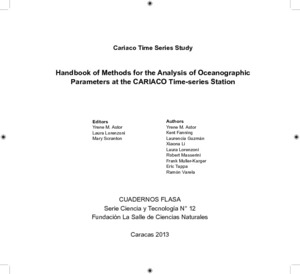| dc.contributor.author | Astor, Yrene M. | |
| dc.contributor.author | Fanning, Kent | |
| dc.contributor.author | Guzmán, Laurencia | |
| dc.contributor.author | Li, Xiaoni | |
| dc.contributor.author | Lorenzoni, Laura | |
| dc.contributor.author | Masserini, Robert | |
| dc.contributor.author | Muller-Karger, Frank | |
| dc.contributor.author | Tappa, Eric | |
| dc.contributor.author | Varela, Ramón | |
| dc.contributor.editor | Astor, Yrene M. | |
| dc.contributor.editor | Lorenzoni, Laura | |
| dc.contributor.editor | Scranton, Mary | |
| dc.coverage.spatial | Cariaco Basin | |
| dc.date.accessioned | 2017-11-25T10:22:10Z | |
| dc.date.available | 2017-11-25T10:22:10Z | |
| dc.date.issued | 2013 | |
| dc.identifier.citation | Astor, Y.M., Lorenzoni, L. and Scranton, M. (eds) (2013) Handbook of Methods for the Analysis of Oceanographic Parameters at the CARIACO Time-series Station: Cariaco Time Series Study. Caracas, Venezuela, Fundación La Salle de Ciencias Naturales, 178pp. (Serie Ciencia y Tecnología N° 12). DOI: https://doi.org/10.25607/OBP-1543 | en_US |
| dc.identifier.uri | http://hdl.handle.net/11329/384 | |
| dc.identifier.uri | https://doi.org/10.25607/OBP-1543 | |
| dc.description.abstract | The focus of the program “CARIACO Oceanographic Time Series” is the collection of a set of oceanographic, biogeochemical and ecological observations at a specific location (10° 30'N, 64° 40'W), in the deepest area of the Eastern basin of the Cariaco Basin, off the coast of Venezuela. The CARIACO program was established in 1995 with the key objective to contribute critical data for monitoring the carbon cycle and biogeochemistry in the seas of the globe, understand the impact of climate change on biodiversity and regional marine ecology, as also supporting research on past climatic changes. Through the collection of long-term ecosystem observations of the Cariaco Basin with data of very high quality at a reasonable time, the scientific community of Venezuela contributes to the knowledge of mankind in these areas, taking scientific advantage of this particular site.
CARIACO is one of the three longest oceanographic biogeochemical time series stations established around the world. The other two are the Hawaii Ocean Time-series (HOT; 22° 45'N, 158° 00'W) and Bermuda Atlantic Time-series Study (BATS; 31° 45'N, 64° 10'W). HOT and BATS serve as platforms for the study of changes in the Pacific and North Atlantic Ocean, respectively, while the CARIACO time series is located in a tropical environment in a continental margin. The scientific achievements of these three stations have encouraged other countries to develop plans to establish similar time series. The region that examines CARIACO is unique for having an annual primary production which doubles approximately production and vertical flow of organic particulate matter observed in the most oligotrophic waters monitored by HOT and BATS. The CARIACO program also offers the opportunity to study the ecosystem along a gradient oxic/anoxic which lies between 200 and 350 m deep. The Cariaco Basin is also an important place for paleoclimatic studies. | en_US |
| dc.language.iso | en | en_US |
| dc.publisher | Fundación La Salle de Ciencias Naturales | en_US |
| dc.relation.ispartofseries | Serie Ciencia y Tecnología;12 | |
| dc.subject.other | GO-SHIP | en_US |
| dc.subject.other | Phytoplankton | en_US |
| dc.subject.other | Sampling procedures | en_US |
| dc.subject.other | Salinity | en_US |
| dc.subject.other | Hydrogen sulfide | en_US |
| dc.subject.other | Dissolved oxygen | en_US |
| dc.subject.other | pH | en_US |
| dc.subject.other | Alkalinity | en_US |
| dc.subject.other | Spectral absorption coefficients | en_US |
| dc.subject.other | Organic matter | en_US |
| dc.subject.other | Nitrogen | en_US |
| dc.subject.other | Organic carbon | en_US |
| dc.subject.other | Chlorophyll a | en_US |
| dc.subject.other | Phaeopigments | en_US |
| dc.subject.other | Primary production | en_US |
| dc.title | Handbook of Methods for the Analysis of Oceanographic Parameters at the CARIACO Time-series Station: Cariaco Time Series Study. | en_US |
| dc.type | Report | en_US |
| dc.description.status | Published | en_US |
| dc.format.pages | 178pp. | en_US |
| dc.description.refereed | Refereed | en_US |
| dc.publisher.place | Caracas, Venezuela | en_US |
| dc.subject.parameterDiscipline | Parameter Discipline::Chemical oceanography::Dissolved gases | en_US |
| dc.subject.parameterDiscipline | Parameter Discipline::Chemical oceanography::Carbon, nitrogen and phosphorus | en_US |
| dc.subject.parameterDiscipline | Parameter Discipline::Chemical oceanography::Nutrients | en_US |
| dc.subject.parameterDiscipline | Parameter Discipline::Chemical oceanography::Other inorganic chemical measurements | en_US |
| dc.subject.instrumentType | Instrument Type Vocabulary::CTD | en_US |
| dc.subject.instrumentType | Instrument Type Vocabulary::continuous water samplers | en_US |
| dc.subject.instrumentType | Instrument Type Vocabulary::dissolved gas sensors | en_US |
| dc.subject.dmProcesses | Data Management Practices::Data acquisition | en_US |
| dc.description.currentstatus | Current | en_US |
| obps.resourceurl.publisher | http://cariacodev.cbm.usb.ve/wp-content/uploads/2013/08/7A-Cuadernos-FLASA-12-Ingles-30-07-2013.pdf | |
 Repository of community practices in Ocean Research, Applications and Data/Information Management
Repository of community practices in Ocean Research, Applications and Data/Information Management
